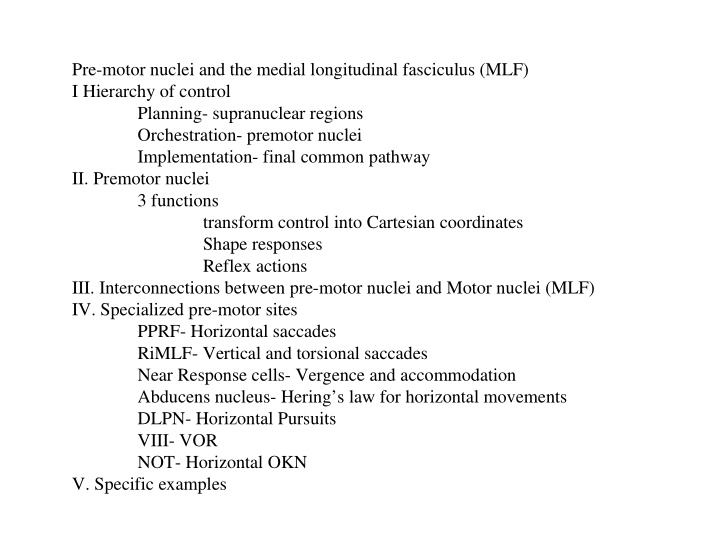



Pre-motor nuclei and the medial longitudinal fasciculus (MLF) I Hierarchy of control Planning- supranuclear regions Orchestration- premotor nuclei Implementation- final common pathway II. Premotor nuclei 3 functions transform control into Cartesian coordinates Shape responses Reflex actions III. Interconnections between pre-motor nuclei and Motor nuclei (MLF) IV. Specialized pre-motor sites PPRF- Horizontal saccades RiMLF- Vertical and torsional saccades Near Response cells- Vergence and accommodation Abducens nucleus- Hering’s law for horizontal movements DLPN- Horizontal Pursuits VIII- VOR NOT- Horizontal OKN V. Specific examples
Hierarchy of Oculomotor Control Supra-nuclear Neurons Cortical Gaze control Cortical Gaze control Motor Voluntary control, (FEF, MT, V1, V2) (FEF, MT, V1, V2) spatial frame of reference Visual Pre-motor Neurons PreMotor Gaze Centers PreMotor Gaze Centers Reflex movement, (VI, VIII, riMLF, PPRF, pulse generation, (VI, VIII, riMLF, PPRF, i.n.Cajal, S.C.) integration i.n.Cajal, S.C.) Adaptive Adaptive control Motor neurons control Oculomotor Nuclei Oculomotor Nuclei (Cerebellum) Final common path, (Cerebellum) ( III, IV, VI) ( III, IV, VI) reciprocal innervation Muscles Oculomotor plant
Hierarchy of Control Planning- Supranuclear regions Orchestration- Premotor nuclei Implementation- Final Common Pathway
Brain stem sites of cranial nerves- Final Common Pathway
Orchestration- Premotor nuclei Functions: Transform eye movement control into Cartesian coordinates. (Horizontal, Vertical & Torsional) Activate combinations of muscles needed to perform eye movement (implement Hering’s law) Specialized control the temporal properties (velocity and position codes for saccades) Separate specialized areas for reflex and voluntary responses- (e.g. OKN and Pursuits)
Medial Longitudinal Fasciculus (MLF) Projections from pre-motor nuclei to the Final Common Pathway. Pathways run longitudinally (rostral-caudal) in the reticular formation. They interconnect pre-and post motor nuclei.
Specialized pre-motor sites: PPRF - Horizontal saccades RiMLF - Vertical Saccades and Torsion Near Response Cells - vergence and accommodation AKA supraoculomotor nucleus Abducens nucleus - interneurons for Hering’s law of yoked horizontal eye movements DLPN - Horizontal pursuits VIII - VOR NOT - OKN
Brain stem sites of cranial nerves- Final Common Pathway
Pathways for the Horizontal VOR during leftward head rotation
Lesions affecting horizontal version LE LE RE RE 1 Oculom otor Op h th alm o p le gia 1 2 Abducen s palsy III 2 3 Un ilateral INO ( I n te rN u c le a r O p h th alm o p le gia) 3 4 On e an d a Half 4 Sy n d ro m e MLF 5 5 Foville's Syn drom e (Posterior INO) VI
Bilateral INO QuickTime™ and a Photo - JPEG decompressor are needed to see this picture
Right Unilateral INO
Foville’s Syndrome with saccades
Foville’s Syndrome VOR
Foville’s Syndrome and convergence
Parinaud’s Syndrome- vert saccades
Specialized cells within the premotor area PPRF for generating saccades. Burst Cell determine the velocity of a saccade Overcome viscosity to achieve high velocity Tonic cells maintain the new eye position at the end of a saccade Cells in other areas of the brainstem (prepositus) that interact with burst and tonic cells Neural Integration transforms burst activity into tonic cell activity Pause Cell determine the duration of a saccade Triggers the burst cell activity like a car clutch
Amplitude of a saccade is determined by the duration and amplitude of the burst.
Pause, Burst and Integration circuit Pause Cell Burst Cell Oculomotor Neuron Eye position Neural Integration
Brainstem Burst and Integrator regions V Integrator H Integrator V Burst H Burst
Main sequence diagram plots velocity or duration as a function of saccade amplitude. 10 deg saccade lasts 50 msec. Saccades are rarely longer than 100 msec Main sequence reflects the activity of Burst neurons.
Recommend
More recommend